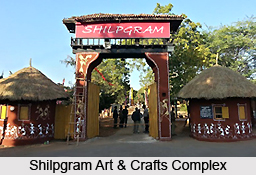 A trip to Shilpgram in Udaipur will prove to be a unique experience for the tourists. Rajasthan has always been famous for arts and crafts. In ancient the handicraft industry received royal patronage. But today with the monarchy system being abolished something different needed to be done to sustain these artists. Besides the economic factor the Shilpgram is also instrumental in exhibiting to the world the artistry of Rajasthan. It is a Rural Arts and Crafts Complex that receives support from the Indian Central Government. Shilpgram is situated in the vicinity of Havala village, west of Udaipur. Constructed on 130 bighas of land it features numerous ethnic groups and their artwork.
A trip to Shilpgram in Udaipur will prove to be a unique experience for the tourists. Rajasthan has always been famous for arts and crafts. In ancient the handicraft industry received royal patronage. But today with the monarchy system being abolished something different needed to be done to sustain these artists. Besides the economic factor the Shilpgram is also instrumental in exhibiting to the world the artistry of Rajasthan. It is a Rural Arts and Crafts Complex that receives support from the Indian Central Government. Shilpgram is situated in the vicinity of Havala village, west of Udaipur. Constructed on 130 bighas of land it features numerous ethnic groups and their artwork.
Within the complex, huts are constructed where the art works are displayed. Apart from Rajasthan four other states from western India also participate in the Shilpgram event. The fundamental motto of this cultural center is to present the dexterity of the Indian craftsmen to the rest of the world. In 1989 it began with the establishment of an ethnographic museum. From then on the village cum exhibition center attracts numerous tourists each year. Connoisseurs of art will love this place. The 26 huts display the amazing artifacts made by the tribal artists.
A visit to Shilpgram will be enriching as one can gather a lot of information about rural art and craft. It is also the place where the generation next can be introduced to the riches of Indian fine arts. Emphasis is also laid on workshops for children where they are briefed about Indian arts and crafts. Apart from the visitors it is also an enriching experience for the artists. Both the rural and the urban craftsmen interact at this cultural exhibition.
 Government of India has developed two museums at Shilpgram. Both these museums display products that are of daily use yet there is a sense of aesthetics related to it. The Crafts Bazar is set up in the ancient haat system. Everything about Shilpgram is essentially traditional. And where there is tradition Rajasthan can never be far behind.
Government of India has developed two museums at Shilpgram. Both these museums display products that are of daily use yet there is a sense of aesthetics related to it. The Crafts Bazar is set up in the ancient haat system. Everything about Shilpgram is essentially traditional. And where there is tradition Rajasthan can never be far behind.
It is a fantastic platform for the Rajasthani artists to exhibit their talent to the rest of the world. So whether it the blue pottery or the intricate stone sculpturing, the visitors will be able to catch a glimpse of all kinds of Rajasthani art. it is surprising that numerous artifacts can be used in day to day life. Products made of terracotta art, wooden and metal objects, leather goods and even agricultural tools are available at the Rajasthani huts in Shilpgram.
5 huts in integrated pattern are set up here. These represent the weaver community of Marwar. Two huts belonging to the villages of Rama and Sam are also to be found. From the erstwhile kingdom of Mewar a potter`s hut is presented and lastly there are 2 more huts that display the skills of the tribal communities of Bhil and the Sehariyas of the Southern regions of Rajasthan. The closest region to Udaipur amongst these is the Dhol village that demonstrates the Mewari artistry.
Another major attraction at Shilpgram is the open-air amphitheatre. It can accommodate nearly 8000 people. Theater performances take place in this auditorium. It aims at popularizing the tribal performing arts. Shilpadarshan is a continuing activity at Shilpgram. The traditional artists and folk performers are invited from the interiors of the Rajasthani and other villages so that they have the opportunity to introduce their art to the world. The craftsmen are encouraged to sell their products to the visitors. This is one way of interacting with the guests and making them aware of the traditional art. Shilpgram in Udaipur has given a huge boost to the handicrafts industry and folk performers.



















